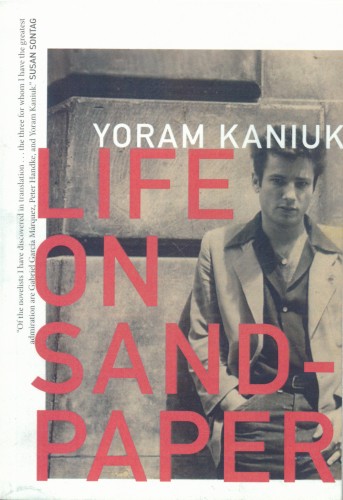Life On Sandpaper
The book reads and feels like a memoir, yet the author insinuates in a foreword that it might be fiction. He also quotes Aristotle in this regard: "The poet and the historian differ in that one relates what has happened, the other what may happen."
Regardless
of whether it is a novel or autobiography, LIFE ON SANDPAPER by the Israeli
author Yoram Kaniuk (translated from the Hebrew by Anthony Berris) is
a remarkable literary achievment, a book which is brimming over with life,
music, art, sex, humor, pain and love. Written with unflagging energy
and an admirable command of language, LIFE ON SANDPAPER makes for fiercely
enjoyable reading.

The hero of the book is known simply as Yo. In his first-person narration
he tells of arriving in the Greenwich Village of the 1950s, after having
fought and been wounded in Israel's War of Independence. Yo is 19, slim,
pale and handsome, a would-be painter with a passion for women, jazz,
poetry and freedom. Within months he manages to learn English (by reading
detective novels), bed several beautiful women, land a job washing dishes
at Minton's Playhouse (the famed Harlem jazz joint), make friends with
Larry Rivers, James Agee and Charlie Parker.
"He was a huge and intimidating sentimentalist and the first time I heard him I felt like I was seeing God die," he says of the latter. "When he played a song and his high forehead was covered with sweat, the music searched for itself between his hands playing the saxophone."
Parker remains a character in the book, turning up here and there during Yo's 417-page odyssey, an odyssey which took him from the Village to Jerusalem (for an exhibition of his paintings) to Rome, London, and then back to New York, where he married a beautiful young dancer (Bob Fosse's favorite), befriended Bird's widow, Chan, met Stanley Kubrick, James Dean, Robert DeNiro, Sr. (a fellow painter) and Jerome Robbins, then drove to Las Vegas with an Israeli friend whose gambling winnings came to the attention of the Jewish mafia who then, very politely, told them "that it would be better if we didn't show our faces in the clubs any more."
The ever-restless, ever-questing Yo continued his American adventures, marrying a second time (to the daughter of rabid anti-semites), opening an Israeli cafe (which failed), becoming a photographer, then a bartender, writing a novel which he sold by walking in unnanounced on a New York publisher and conning him into reading it.
For sheer chutzpah and bravado Yo can't be beat. For ten years he lived New York life to the hilt, taking part in the post-war creative explosion (bebop, abstract expressionism, off-Broadway theatre, novels by Mailer and Jones). He also deeply involved himself in the lives of his friends and lovers; attending weddings and funerals, gallery openings and closings; trying to be a decent husband and father.
Finally, Yo swapped the USA for Israel and gave up painting for writing. Now, after having published more than thirty books (including the novel from which the film Adam Resurrected was adapted), he has given us the remarkable, aptly-titled LIFE ON SANDPAPER. Published in ppbk. by Dalkey Archive, $15.
